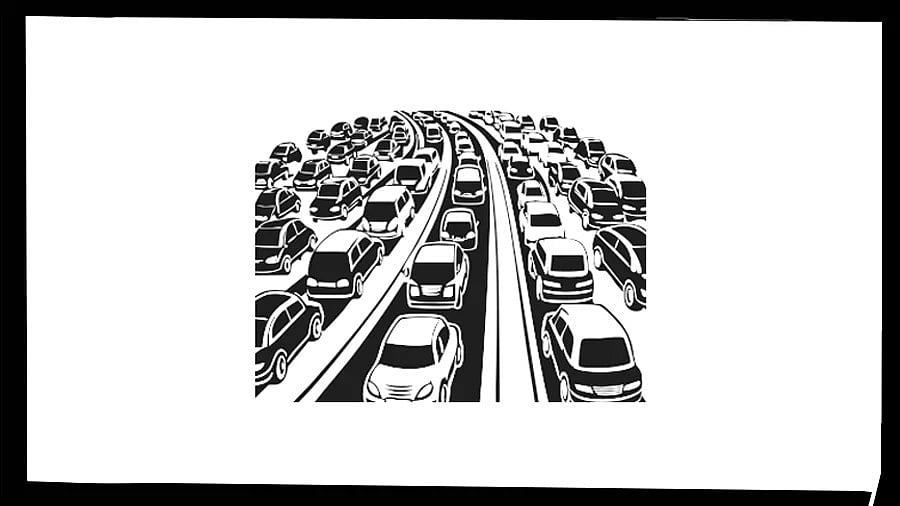
Bengaluru, one of the fastest-growing cities globally, is projected to achieve a GDP growth rate of 8.5 per cent over the course of the decade. The city’s rise is driven by its core strength of being a renowned innovation hub, with its leading Global Capability Centres, start-ups, biotech and R&D landscape that attract talent and investment from across the world. This growth and dynamism also present a conundrum: jobs, population and vehicles have multiplied faster than the city’s ability to move people, making mobility Bengaluru’s Achilles’ Heel.
So far, the city has grappled with rising congestion in a reactive way, wherein we have not really addressed underlying structural imbalances while continuing to focus on quick fixes. Last year’s Tom Tom Index ranked Bengaluru as the city with the third-worst traffic in the world, leading to losses of about Rs 19,725 crore annually owing to loss of time and resources spent while navigating traffic. In August 2025 alone, Bengaluru added 58,913 private vehicles to its already choked roads. With more than 1.06 crore private two-wheelers and cars, our transport infrastructure is rapidly spiralling into permanent gridlock. For instance, on stretches like the Outer Ring Road and Sarjapur Road, the volume-to-capacity ratio ranges from 2.0 to 3.5, signifying traffic loads two to three times higher than the designed capacity, leading to constantly congested roads.
In the short term, the city must first fix the basics: smooth carriageways, pothole-free roads, bypasses, synchronised traffic signals and retrofitted junction designs that allow traffic and pedestrians to flow freely. Employers across Bengaluru should embrace staggered work hours, flexible schedules and work-from-home options to ensure all our roads are not choked all at once.
Parallelly, a Comprehensive Mobility Plan (CMP) must be initiated, backed by household travel surveys, volume counts, and origin-destination surveys that can indicate how people move and where. This will help us identify where bottlenecks persist and where targeted interventions will be the most impactful.
The sustainable solution, however, lies in addressing the root causes that lead to these bottlenecks with a long-term and multi-pronged approach. Bengaluru has rightly invested in expanding its public transport over the past decade as a strategy to reduce congestion. Currently, 96.1 km of metro lines are operational, while 79.44 km are under construction. While the metro network expands, the city’s bus services have remained fairly stagnant over the past decade and they too, are stuck in the same gridlocks as private vehicles, significantly limiting their ridership potential. For a global tech capital, the lack of full digitisation in bus operations and planning reflects a glaring mismatch between potential and practice.
To transform its mobility system and fully realise the benefits of public transport investments, Bengaluru must get three key things right:
1. Ensure robust last-mile services. The metro lines that have already been approved but are languishing under ‘work in progress’ for years need to be urgently fast-tracked, alongside higher-frequency bus routes, especially along the peripheries, that can absorb rising demand. Reliable feeder services to mass transit can improve ridership considerably. Alongside, high-footfall corridors should have pedestrian subways that allow safe crossings and universal accessibility to ease crowding. Also, long overdue in the city are shared mobility reforms that can ensure that these solutions remain an attractive last-mile option for commuters.
2. Build secondary and tertiary networks. Area development in peripheral zones must embed secondary and tertiary road networks from the start, so growth is supported by planned infrastructure rather than by building flyovers as an afterthought. For instance, Jayanagar has a well-developed secondary and tertiary road network, with a road density of 23 km per sq km, compared to just 8 km per sq km in Whitefield. Expanding these networks in a phased manner over the next decade (particularly in high-congestion areas) will be critical to maintaining smooth traffic flow.
Bengaluru will need to develop an ambitious, phased plan to complete the missing links in the road network that act as barriers to vehicular circulation and access. This includes providing access through private thoroughfares where necessary. Expanding these networks requires not just engineering but careful urban planning. Land acquisition, rehabilitation and resettlement are essential components to be considered to minimise the human cost of development. Acquiring land involves negotiating with multiple stakeholders and navigating legal complexities. Cities such as Mumbai and Ahmedabad demonstrate that it is possible to balance these priorities if we plan comprehensively and execute seamlessly.
3. Manage parking efficiently. Across the city, vehicles are frequently parked illegally on footpaths, cycle lanes, and in front of bus stops, hindering pedestrian movement, causing traffic jams, and creating safety risks. It’s time we move from passive and weak enforcement of parking regulations to active management of parking demand. Urban local bodies should consider parking management as one of their key functions and deliver parking services systematically and efficiently.
Additionally, parking can no longer remain subsidised; pricing it rationally will discourage unnecessary private vehicle trips and make public transport the more attractive choice for commuters.
With induced and latent demand, incremental solutions like building new flyovers will only yield diminishing results. Solving Bengaluru’s mobility gridlock is a long-term game that requires foresight, patience, and a multi-pronged approach with the ability to take bold decisions. Bengaluru requires a shared willingness from all stakeholders to come together, build consensus, and pursue solutions relentlessly, no matter how complex or challenging they may appear. If Bengaluru aims to remain a competitive and attractive global destination, it must address its transportation challenges in a methodical and coordinated manner, and it must do it now.
(Madhav is CEO, WRI India. Pawan is Executive Director – integrated transport, clean air and hydrogen, Sustainable Cities Programme, at WRI India)
Disclaimer: The views expressed above are the author's own. They do not necessarily reflect the views of DH.